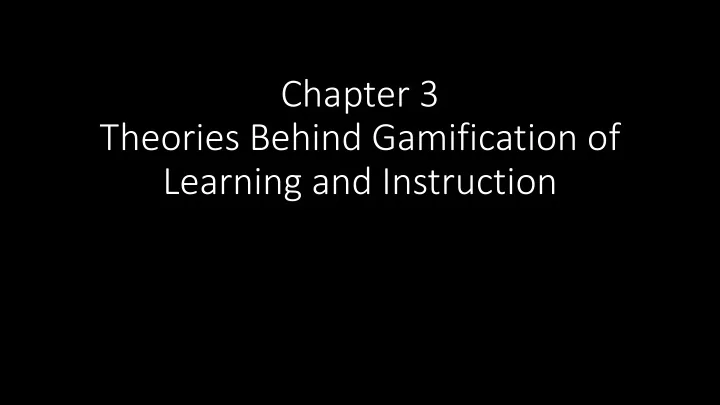

Chapter 3 Theories Behind Gamification of Learning and Instruction
Overview • What learning theories support the use of games within the instructional process? • What elements of motivational theory apply to the gamification of learning and instruction?
Introduction • How learning theory support the use of games? • Operant conditioning and the reinforcement schedules • Are the distributed practice, social learning theory, achieving the flow state, scaffolding and game levels, and the power of episodic memory?
Motivation • Intrinsic Motivation • Is the motivation primarily driven from within the learner? • Extrinsic Motivation • Is the motivation from some external factor? This is known as extrinsic motivation
Intrinsic Motivation • When a person undertakes an activity for its own sake • Open a book and read for self-fulfillment, not because of some external reward • May lead to a greater depth of learning and more creative output • Rewards come from the carrying out an activity rather than from the result of the activity.
Extrinsic Motivation • Behavior undertaken in order to obtain rewards or avoid punishment • Grade, praise, certificate, badge, reward, prize or admiration from others • We will have six motivation models that describe elements of both intrinsic and extrinsic motivations.
1. ARCS Model • Well known model in the field of instructional design • Used as a framework in creating e-learning and courseware • Attention – Perceptual, inquiry, variability • Relevance – Goal orientation, match motives, familiarity, modeling • Confidence – Clearly state the learning requirements and expectations in the beginning; Small opportunities for success; Different and challenging experiences that build upon one another • Satisfaction – Opportunity to apply new knowledge and skills; Positive encouragement and reinforcement.
2. Malone’s Theory of Intrinsically Motivating Instruction • Why games are so much fun and motivational? • Challenge • Goals with uncertain outcomes. • Personally meaningful to the learner • Fantasy • An environment that “evokes mental images of things not present to the senses or within the actual experience of the person involved” • Can make instructional environments more interesting and more educational • Extrinsic and Intrinsic fantasies • Curiosity • An optimal level of informational complexity and a novel and exciting environment • Sensory and Cognitive curiosity • Random surprising feedback for engagement.
3. Lepper’s Instructional Design Principles for Intrinsic Motivation • Promoting intrinsic motivation in instructional activities to avoid having to rely on extrinsic motivational techniques • Control • Decrease or minimize any extrinsic constraints • Challenge • Goals of uncertain. Timely feedback. Multiple goals and levels. • Curiosity • Areas of inconsistency, incompleteness • Contextualization • Present the activity in a functional simulation or fantasy context
4. The Taxonomy of Intrinsic Motivationf • Internal Motivational: • Challenge • Curiosity • Control terms of the contingency, choice, and power • Fantasy • Interpersonal Motivational: • Cooperation • Competition • Recognition
5. Operant Conditioning • Create operant conditioning • Choose a proper reward schedules
6. Self-Determination Theory (SDT) • Autonomy • A person has the feeling that they are in control and can determine the outcome of their actions. • Competence • A need for challenge and a feeling of mastery. • Relatedness • Experienced when a person feels connected to others. Online multiplier game or friends or families are playing together.
Distributed Practice • What is distributed practice? • Also called spaced practice, or spaced rehearsal • Opposite: Mass Practice • Robust and powerful phenomenon in learning • Long-term retention and recall of content • Avoid fatigue and less efficient • Not better in immediate learning, only for a period of time. • Varying storylines, different areas open, content; no same experience twice
Scaffolding • Different levels • Easy Intermediate Hard • Demonstration Practice Test • Progressive disclosure
Social Learning • Human social models can be effective in influencing another person to change behaviors, beliefs, or attitudes. • Virtual Human
Flow • Achievable Task • Concentration • Clear Goals • Feedback • Effortless Involvement • Control Over Action • Concern for Self Disappears • Loss of Sense of Time
Recommend
More recommend